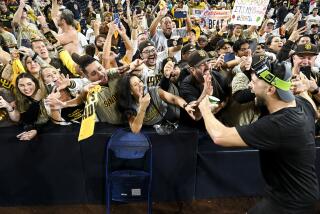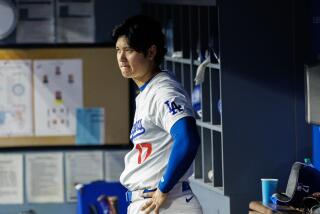THE ROOKIES : Padres Are Giving the Class of â86 a Chance This Year, and Maybe Next
SAN DIEGO â Jimmy Jones started out with a flash of brilliance, but in his second start he looked more like a flash in the pan.
Gary Green has played shortstop like Mark Belanger, but heâs hit like Enzo Hernandez.
Randy Asadoor is batting close to 400, but his fielding percentage is only slightly higher.
And so it goes with the Class of â86. The best of the Pacific Coast League champion Las Vegas Stars have invaded San Diego. For the past two weeks--hardly the blink of an eye as baseball seasons go--they have dazzled, thrilled, amused and, at times, disappointed the local faithful.
Since Manager Steve Boros all but handed over the rest of the season to a bunch of kids barely old enough to drink a beer--outside the clubhouse, of course--the Padres are 5-8. Thatâs only a tad worse than what Boros was able to squeeze from his regulars during the seasonâs first five months.
But before you rush out and buy season tickets for 1987 with hopes of seeing them with the Padres, be advised. Only a couple of the Starlets figure to be with the Padres next season.
Of the eight players the Padres called up this month for their first taste of major league action, only catcher Benito Santiago is considered by Boros complete enough to win a job in the majors today. A few others--Green, Asadoor, maybe Jones--might have a shot, but it would be a long shot.
Hereâs a rundown on the eight, starting with position players:
Benito Santiago. A native of Ponce, Puerto Rico, Santiago, 21, is, as Boros said, âat the head of the class.â
Santiagoâs hitting has cooled off after a strong start. Heâs batting .273, with two home runs and five runs batted in. His first homer was a 10th-inning hit to beat the Giants on Sept. 17.
Santiagoâs strength is supposed to be his fielding, and he has been sharp defensively. Heâs often described as a Tony Pena-type catcher and, like Pena, Santiago loves to throw the ball. He will whip it to any base at any time. In the eighth inning of one close game in Atlanta, Santiago picked Ken Oberkfell off second, and he made the snap throw without even standing up.
But Santiago also has lacked concentration at times, Boros said. In the game he won with his first home run, Santiago blew a rundown play by chasing a runner all the way back to third. If Santiago had stopped and thrown, he would have had an easy out. Santiago also has made two errors.
âHeâs always had a strong arm, but lately heâs been rushing his throws,â Boros said Sunday. âHeâs been a little erratic.â
Still, Boros said Santiago has played well enough to be given âfirst crackâ at the starting catching job in the spring, even if Terry Kennedy is still with the club.
Gary Green. Green, 6-feet 3-inches, 175-pounds, moves like former Oriole shortstop Mark Belanger. He has great range and a sound throwing arm. In 12 games, Green has yet to make an error.
Green, 24, from Oklahoma State who was a member the 1984 U.S. Olympic baseball team, was drafted by the Padres in 1984 on the strength of his defense.
âEven when we drafted him we said, hey, he can play in the big leagues right nowâ because of his fielding, said Tom Romenesko, the Padresâ minor league director. But can he hit?
In Beaumont in 1985, his first year in pro ball, Green hit .257 against Double-A pitchers. In Las Vegas this year, he hit .249. In 33 major league at-bats, Green has a .212 average.
âThereâs no question Green can be good enough to do the job defensively,â Boros said. âBut the way we scored runs this year, weâve got to have a little offense from our shortstop position, too. Weâre not the kind of club like the New York Mets, who can carry a Rafael Santana as a shortstop whoâs hitting .190-something.â
Green knows he will have to hit, and heâs growing tired of people questioning his ability to do so. During the off-season, he plans to work with Padre trainer Dick Dent to build up strength. He does not want to be tagged with the âall-field-no hitâ label at such a young age.
âItâs not as much fun if youâre not hitting,â Green said. âIt doesnât matter how well you play in the field.â
Green added that there can be a big difference between minor league records and major league performance.
âNobody thought Ozzie Smith would ever hit, and heâs hitting .280,â Green said.
Randy Asadoor. Randy Who? He wasnât even the starting third baseman at the end of the season for Las Vegas, and here he is tearing up the National League. Heâs hitting .385 through 10 games.
âRandyâs always been a streak hitter, and heâs in a positive streak right now,â Romenesko said.
Even Asadoor, 23, admits that his high average is a bit misleading.
âMy first six or seven hits were seeing-eye type hits,â he said. âI wasnât stinging the ball. I was getting a lot of ground balls through the infield and a lot of bloopers over the infield. I was lucky to get off to a decent start. Since then, Iâve felt good and Iâve started to drive the ball a little better.â
But Asadoorâs defense hasnât quite matched up to his hitting. Heâs made five errors in 10 games, not a Gold Glove pace. Asadoor, a graduate of Fresno State, committed 23 errors in Las Vegas in 1985 and 24 this year.
Asadoor also started 12 games in left field for the Stars, and he has played some shortstop and first base. Boros put him at second last week for one inning against the Dodgers and for four innings against the Reds Sunday. He had never played second before.
âI was talking to the second base umpire about that,â Asadoor said. âI was telling him Iâve never turned a double play from second in a game in my life.â
Tim Pyznarski. He was voted the PCLâs Most Valuable Player this year, hitting .326 with 23 homers and 119 runs batted in.
Pyznarski, a soft-spoken Chicago native, has gotten off to a slow start with the Padres. In 34 at-bats, he has hit just .235, without a homer or an RBI. He has struck out eight times.
The Padres have had prospects who put up big PCL numbers only to fizzle in the big leagues. Remember Randy Bass and Rick Lancellotti?
But Romenesko said it would be âharshâ to lump Pyznarski in that group. Pyznarski and the rest of the Stars went through two playoff series before coming to San Diego. And they faced Mike Scott, Mike Krukow and several other tough pitchers in their first few games.
âTwo weeks doesnât make a season,â Romenesko said.
Romenesko said heâs still hoping Pyznarski will turn out more like two other Padres who put up big numbers in the minor leagues: Kevin McReynolds and John Kruk.
Mark Parent. He was drafted by the Padres in 1979. Among the players the Padres have drafted since are Tony Gwynn, Gene Walter, Kruk and McReynolds.
Parent, a 6-5, 215-pound native of Ashland, Ore., has played for Walla Walla, Reno, Grays Harbor, Salem, Amarillo, Beaumont and Las Vegas, where he hit .288 this year.
With San Diego, he was hitless in nine at-bats going into Monday nightâs game against the Dodgers.
But Parent, who twice in the minors has led his league in fielding percentage, may still find work in the majors, say Boros and Romenesko.
âI look around this league and I see (backup) catchers, and I know Mark Parent is as good as any of them,â Romenesko said. âMarkâs going to play in the big leagues and be a good contributor to a major league club.â
The pitchers. Jimmy Jones, Ray Hayward and Ed Vosberg all had earned-run averages above 4.40 at Las Vegas this year and their records were a combined 25-29--not exactly the Stars to hang your dreams upon.
Boros dismisses the earned-run averages because they were compiled in the PCL, where hard infields, short fences and light air wreak havoc on pitchersâ statistics.
Jones and Hayward were back-to-back No. 1 selections in the 1982 and 1983 drafts, the kind of choices expected to make a dramatic impact. Jones was the third player taken in the first round in 1982. The fifth player chosen was Dwight Gooden.
Jonesâ career has been hampered by injuries. In 1983, 1984 and 1985, his season ended in July. The first year, he developed tendinitis in his right arm. The next year, he stepped in a hole before a game in El Paso, tearing ligaments in his ankle. In 1985, a knee injury forced him to miss the second half of the season.
Jones, 22, had his first injury-free season since 1982 this year in Las Vegas. He was 9-10 with a 4.40 ERA in 28 games. In 158 innings, he struck out 114 and walked 72.
In his final five regular-season games--after teammate Ed Wojna taught him a new curveball--Jones was 4-1 with a 1.90 ERA. The Stars were shutout, 2-0, in his only loss.
In his major league debut against the Astros in Houston, Jones was magnificent. He allowed no runs, one hit, walked none and struck out five. He pitched to one batter over the minimum 27 and he retired the final 19.
Then Jones came home, and came down to earth. In his second start, against Cincinnati, Jones barely made it through two innings. He gave up four runs, three earned, and was only spared further damage when Tony Gwynn threw out Dave Parker trying to stretch a single into a double to end the second inning. Jones left for a pinch-hitter in the bottom of the inning.
Jones, a native of Dallas, said he was more nervous in his first game in San Diego than he was in Houston.
âI knew I could go out in Houston and do halfway decent,â he said. âI didnât think it would turn out that way. I pressured myself into going out and making it happen again. It just wasnât there.
âAfter that game, I felt like 1,000 pounds was lifted off my chest.â
Jones will have one more start--Wednesday against the Dodgers. Between that game and his performance next spring, Jones thinks he will have a solid shot of making the team.
âI just want them to think about keeping me at least,â he said. âIf they send me down again, I want it to be tough for them.â
Hayward, who started Monday against the Dodgers, was the 10th player taken in the June, 1983, draft. In Las Vegas this year, he was 9-11 with a 4.63 ERA.
Hayward, from Enid, Okla., said 1986 was the worst year he has had as a pitcher. He was plagued most of the season with a sore arm, though it was never bad enough to force him out of action.
âI didnât pick up a ball at all in spring training,â he said. âI barely made my first start in Vegas, got through it and just kept pitching. When my arm started feeling better, I was compensating for it and got sore in other places. I just struggled all year long.â
Going into Monday nightâs game, Hayward (0-1) had given up 8 runs in 7 innings.
Vosberg, who turned 25 Sunday, didnât get much of a birthday present from the Reds, who cuffed him around for two innings. In three starts, Vosberg has allowed 8 runs on 15 hits in 11 innings.
More to Read
Go beyond the scoreboard
Get the latest on L.A.'s teams in the daily Sports Report newsletter.
You may occasionally receive promotional content from the Los Angeles Times.










